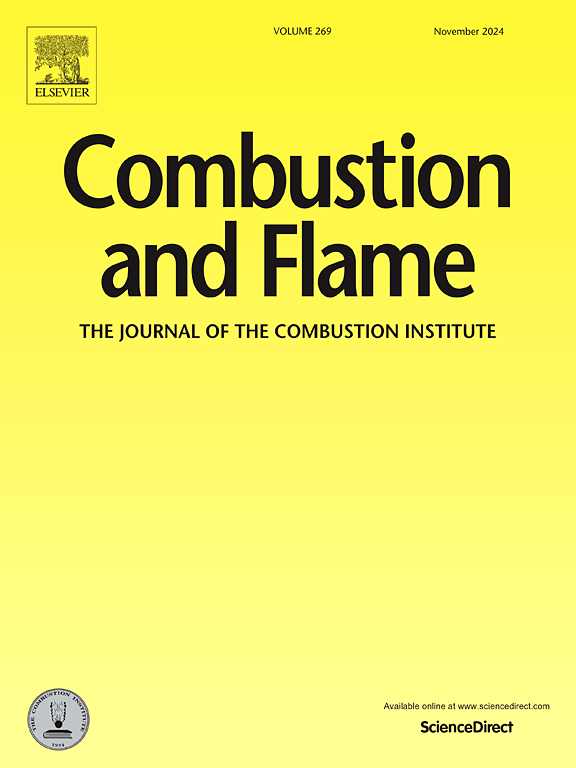Theoretical investigation on unimolecular decomposition network of n-propylamine with advanced kinetic methods
IF 5.8
2区 工程技术
Q2 ENERGY & FUELS
引用次数: 0
Abstract
Unimolecular decomposition network of -propylamine (NPA) is theoretically investigated. Twenty intramolecular H-shift/H elimination reactions and three bond dissociation reactions are identified, including some new reactions producing singlet species. Among these reactions, only one intramolecular H-shift reaction that yields CH + NH and three bond dissociation reactions are dominant. The M06-2X/jun-cc-pVTZ and M06-L/jun-cc-pVTZ methods are adopted for kinetic calculations given their well-balanced accuracy and computational costs. The reaction-path variational transition state theory and variable reaction coordinate variational transition state theory are applied to determine the high-pressure limit rate constants of the intramolecular H-shift reaction and bond dissociation reactions, respectively, and the multi-structure torsional anharmonicity and small-curvature tunneling correction are considered. The pressure-dependent rate constants are also determined using the system-specific quantum Rice–Ramsperger–Kassel theory at 700–2000 K and 0.001–100 atm. The C–C bond dissociation reaction that produces CHCH and CHNH radicals is the most important with a branching ratio larger than 0.85 over the investigated temperature range. Our calculated rate constants agree well with the literature data and effectively capture the effect of pressure on the rate constants within the uncertainty in energy determination. With our calculations, a literature combustion model is updated and performs better in predicting the speciation data during the NPA pyrolysis and ignition delay times of NPA.
Novelty and Significance statement
This work theoretically investigates the unimolecular decomposition network of -propylamine (NPA) by using the advanced reaction-path variational transition state theory and the variable reaction coordinate variational transition state theory for reactions with tight and loose transition states, respectively, with the consideration of multi-structure torsional anharmonicity and small-curvature tunneling correction. Some novel unimolecular decomposition reactions producing singlet species are reported. The pressure-dependent rate constants are determined using the system-specific quantum Rice–Ramsperger–Kassel theory at 700–2000 K and 0.001–100 atm. The C–C bond dissociation reaction that produces CHCH and CHNH radicals is predominant. Based on our calculations, a literature combustion model is updated, exhibiting a better performance in predicting the speciation data during the NPA pyrolysis and ignition delay times of NPA.
求助全文
约1分钟内获得全文
求助全文
来源期刊

Combustion and Flame
工程技术-工程:化工
CiteScore
9.50
自引率
20.50%
发文量
631
审稿时长
3.8 months
期刊介绍:
The mission of the journal is to publish high quality work from experimental, theoretical, and computational investigations on the fundamentals of combustion phenomena and closely allied matters. While submissions in all pertinent areas are welcomed, past and recent focus of the journal has been on:
Development and validation of reaction kinetics, reduction of reaction mechanisms and modeling of combustion systems, including:
Conventional, alternative and surrogate fuels;
Pollutants;
Particulate and aerosol formation and abatement;
Heterogeneous processes.
Experimental, theoretical, and computational studies of laminar and turbulent combustion phenomena, including:
Premixed and non-premixed flames;
Ignition and extinction phenomena;
Flame propagation;
Flame structure;
Instabilities and swirl;
Flame spread;
Multi-phase reactants.
Advances in diagnostic and computational methods in combustion, including:
Measurement and simulation of scalar and vector properties;
Novel techniques;
State-of-the art applications.
Fundamental investigations of combustion technologies and systems, including:
Internal combustion engines;
Gas turbines;
Small- and large-scale stationary combustion and power generation;
Catalytic combustion;
Combustion synthesis;
Combustion under extreme conditions;
New concepts.
 求助内容:
求助内容: 应助结果提醒方式:
应助结果提醒方式:


